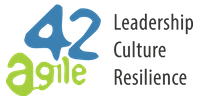Webinar: A decision making approach for resilience (Principle #2)
Nov. 16, 2020
Webinar with agile42 coach Giuseppe De Simone.
Back to the full list of webinars
Webinar with agile42 coach Giuseppe De Simone.
Back to the full list of webinars
agile42 enables leaders and their teams to create a resilient organization and a sustainable change process. We equip them with the tools they need daily to grow the business and foster the right organizational culture.
🇿🇦 South Africa
(Cape Town & Johannesburg)

Back to the full list of webinars
For example, centralized decision-making processes lead to more coherent decisions at the cost of longer information flows and synchronization delays. If decisions are distributed and frequent, the organization might instead be more autonomous and responsive at the cost of process coherence. In both cases the downsides can be partially offset, e.g. by deploying information systems or by increasing the cultural coherence.
Continuing the series on ORGANIC agility, in this webinar we will explore Principle #2 and how to use a common and transparent framework for decision-making processes that adapts to each specific context. Using the Cynefin framework as guidance, we have created a specialized approach to decision-making based on the Cynefin domains, separating out two processes, which are both critical for resilience:
- Situational analysis: this is how the people making the decision perceive the context in which the decision needs to be made.
- Decision-making: how the actual decision-making is carried out, based on the situational analysis.
Both parts of the decision-making process are critical for resilience. In order to quickly recover from failure and adapt to changing circumstances, the organization must have the ability to manage the trade-off between speed, risk, and anticipated consequences.